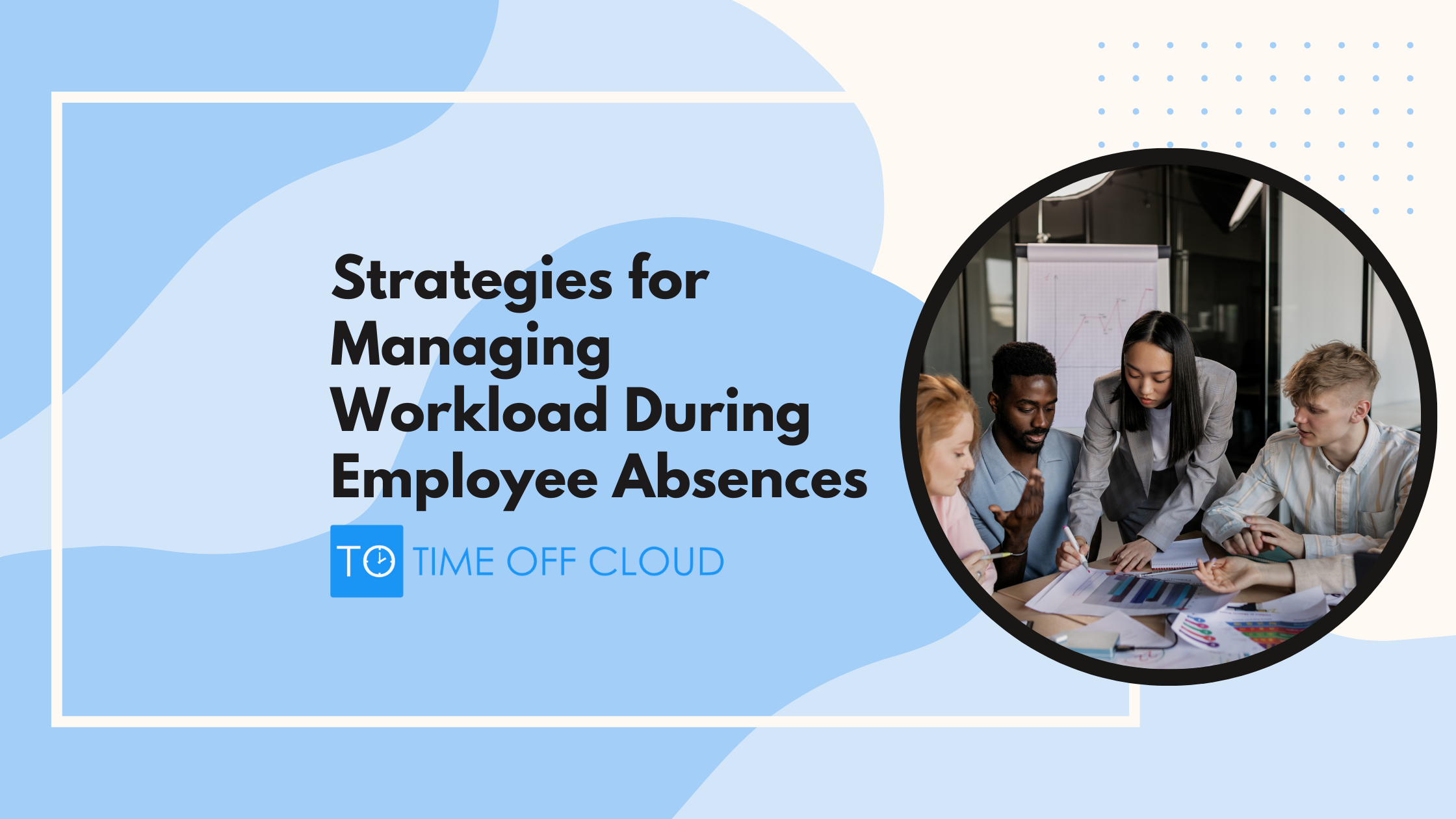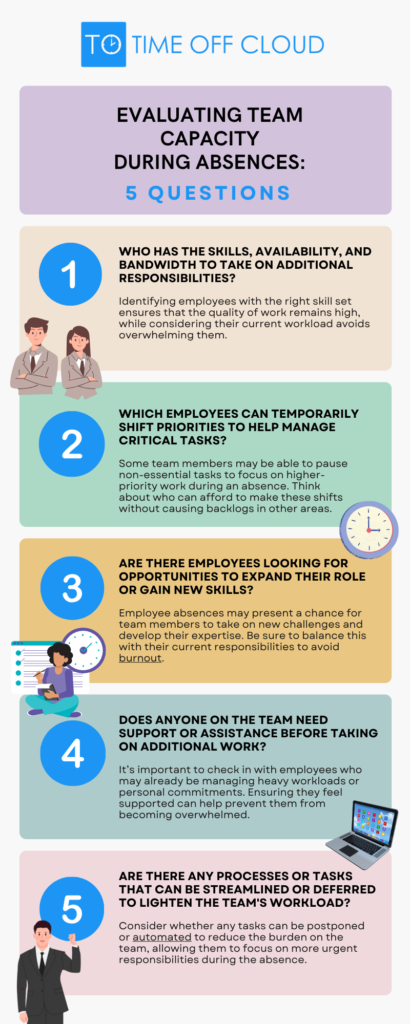Managing employee absences can be a significant challenge for businesses of any size. Whether the absence is planned or unexpected, it’s important to have strategies in place to maintain productivity and ensure that no one feels overburdened. In this post from Time Off Cloud, we’ll explore several effective strategies for managing workload during employee absences, keeping your business running smoothly while supporting your team during these disruptions.
Assessing the Impact of Employee Absences
The first step in managing employee absences is understanding their impact on your organization. Absences can vary in length and complexity, from a single day to extended leaves of absence, such as maternity or medical leave. By assessing the impact of these absences, you can plan accordingly and reduce the likelihood of disruptions.
Identifying Key Responsibilities
When an employee is absent, it’s essential to identify their core responsibilities and tasks that will be affected. Some employees may handle critical functions that cannot be delayed, while others may have duties that can be temporarily postponed. Understanding the nature of their role will help you prioritize tasks and allocate resources effectively.
Evaluating Team Capacity
Once you’ve identified the tasks that need to be covered, evaluate the capacity of your existing team. Consider the following questions:
- Who has the skills, availability, and bandwidth to take on additional responsibilities? Identifying employees with the right skill set ensures that the quality of work remains high, while considering their current workload avoids overwhelming them.
- Which employees can temporarily shift priorities to help manage critical tasks? Some team members may be able to pause non-essential tasks to focus on higher-priority work during an absence. Think about who can afford to make these shifts without causing backlogs in other areas.
- Are there employees looking for opportunities to expand their role or gain new skills? Employee absences may present a chance for team members to take on new challenges and develop their expertise. Be sure to balance this with their current responsibilities to avoid burnout.
- Does anyone on the team need support or assistance before taking on additional work? It’s important to check in with employees who may already be managing heavy workloads or personal commitments. Ensuring they feel supported can help prevent them from becoming overwhelmed.
- Are there any processes or tasks that can be streamlined or deferred to lighten the team’s workload?
Consider whether any tasks can be postponed or automated to reduce the burden on the team, allowing them to focus on more urgent responsibilities during the absence.
Download this infographic to help your team determine how to delegate work:
Cross-Training Employees
One of the most effective strategies for managing workload during employee absences is cross-training employees. By training multiple team members to handle a variety of roles, you create flexibility and resilience within your organization.
Building a Cross-Training Program
To implement a cross-training program, start by identifying the key tasks that are critical to your business. These tasks should be well-documented and easy to follow so that employees can step into new roles with minimal disruption. Pair employees with mentors who can guide them through the learning process, allowing them to practice their new skills during normal working conditions before an absence occurs.
Encouraging Knowledge Sharing
Fostering a culture of knowledge sharing is another way to support cross-training. Encourage employees to share their expertise with others in the team through presentations, workshops, or informal discussions. This approach not only helps with cross-training but also promotes collaboration and innovation within the organization.
Utilizing Technology for Task Management
Technology plays a critical role in managing workload during employee absences. Tools like project management software, PTO tracking systems, and communication platforms can streamline processes, reduce miscommunication, and ensure that tasks are completed on time.
Implementing Project Management Tools
Project management tools, such as Trello, Asana, or Monday.com, allow teams to track tasks, assign responsibilities, and monitor progress. These platforms make it easy to see which tasks need to be completed and who is responsible for them. They also offer transparency and help avoid tasks falling through the cracks during an absence.
Automating Routine Tasks
Automation can help reduce the burden of routine tasks during employee absences. Consider using automation tools to handle recurring activities such as
- Sending reminders
- Generating reports
- Processing payroll
- Managing customer inquiries with automated responses
- Scheduling meetings or appointments
- Tracking project deadlines and progress
Temporary Staffing Solutions
In cases of extended absences, such as parental leave or medical leave, temporary staffing solutions may be necessary. Hiring temporary workers or engaging freelancers can help bridge the gap and ensure that the workload is managed effectively.
Working with Staffing Agencies
Staffing agencies specialize in matching temporary workers with businesses in need. These agencies often have a pool of pre-vetted candidates with the skills required to fill in for absent employees. Working with a staffing agency can save time and reduce the stress of finding temporary help.
Hiring Freelancers
For certain tasks or projects, freelancers can be an ideal solution. Platforms such as Upwork, Fiverr, or Freelancer.com offer access to a global talent pool, allowing you to find specialists for short-term assignments. Freelancers can provide flexibility, especially when you need someone with a specific skill set for a limited period.
Clear Communication and Transparency
Effective communication is key to managing workload during employee absences. Ensuring that all team members are aware of the situation, understand their responsibilities, and have access to necessary resources is essential for maintaining productivity and morale.
Establishing Clear Expectations
When redistributing tasks or bringing in temporary help, it’s important to establish clear expectations. Ensure that everyone involved knows what is expected of them, including deadlines and quality standards. Regular check-ins can help monitor progress and address any concerns that arise.
Keeping Employees Informed
Keep all employees informed of the absence and the steps being taken to manage the workload. This transparency helps prevent misunderstandings and ensures that everyone is on the same page. It also fosters a culture of support and collaboration, which can help boost morale during challenging times.
Offering Flexibility to Your Team
Managing employee absences often requires flexibility from both management and the remaining team members. Offering flexible work arrangements, such as remote work, flexible hours, or part-time schedules, can help your team manage their additional workload without becoming overwhelmed.
Encouraging Work-Life Balance
Encouraging a healthy work-life balance is crucial, especially during times of increased workload. Employees who feel overworked and burned out are less productive and more likely to make mistakes. By promoting work-life balance and offering flexible options, you can help your team stay engaged and motivated.
Providing Support and Resources
Offer support and resources to help employees manage their workload during absences. This could include providing access to time management tools, offering additional training, or even bringing in additional support if needed. When employees feel supported, they are more likely to handle increased workloads effectively.
Planning for Future Absences
Employee absences are inevitable, but with proper planning, their impact can be minimized. By developing contingency plans and proactively addressing potential absences, you can ensure that your business continues to run smoothly.
Creating an Absence Management Policy
An absence management policy outlines the procedures and expectations for both planned and unplanned employee absences. This policy should include guidelines on how absences will be handled, how tasks will be redistributed, and how communication will be managed. Having a clear policy in place will help employees know what to expect and how to prepare for absences.
Contact Time Off Cloud for Absence Management Solutions
Managing employee absences effectively requires careful planning, clear communication, and the right tools. Time Off Cloud offers a comprehensive solution for tracking employee time off, managing absences, and keeping your business on track. Our platform helps you streamline leave requests, monitor trends, and ensure compliance with labor laws. Contact us to learn more, or schedule your free trial now.



